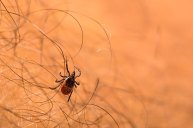This tick-borne disease is more terrifying than Lyme.
Anyone who has spent any amount of time in the outdoors already knows about ticks and likely about Lyme disease. But there is another disease spread by tick bites here in the United States that is much more frightening.
It's called Powassan virus and it's incredibly rare, but something you should be concerned about this summer.
We'll run down the symptoms of Powassan virus and go over how to prevent it during your summer adventures.
What is Powassan Virus?
https://www.youtube.com/watch?v=al5EM3yh—0
Simply put, Powassan virus is a flavivirus. You've likely heard of West Nile virus or Zika virus. Powassan is related to those and is spread through the bite of an infected tick.
The virus was first discovered in 1958 when a boy became very sick and eventually died from the virus in Powassan, Ontario. Thus, that first incident is where the name came from. While the virus has mostly been found here in North America, it has also occurred in parts of Russia.
So, why are these tick-borne flaviviruses so scary? There are many reasons. First off, the virus transmits much faster than Lyme, which transmits in about 24 hours. It is believed Powassan can transmit in as little as half that time. In lab testing, scientists got it to transmit to a mouse in only 15 minutes!
The viral infection is mostly spread through six tick species that have fed on small mammals like mice and woodchucks. The good news is that once it's in a human, it can't spread to the tick and back to other humans, but there are plenty of other frightening things about this virus.
There are two different lineages of the Powassan virus. One is a related virus known as "deer tick virus" or DTV. Either way, both can spread to humans easily.
Here is the really scary part of Powassan: it can cause encephalitis, an infection and inflammation of the brain. If untreated, it can lead to Menigoencephalitis, which is similar, although not quite the same as meningitis. Cases of Powassan often require hospitalization and additional supportive care after recovery.
A Powassan virus infection can also cause seizures, memory problems, muscle wasting, speech difficulties, spinal cord and nervous system problems, loss of coordination, aphasia (brain damage affecting your ability to understand language), and in one Connecticut case an infant had encephalomalacia (softening of brain tissue) and scarring of the brain. In that incident, the parents believe the toddler may have been bitten by a tick the father brought home on his hunting clothing. Thankfully, the boy made a full recovery.
About ten percent of Powassan cases in humans end in death. Many more survivors, at least half, end up with permanent disabilities. Health care is limited. There is no vaccine or cure for the virus.
Powassan Virus Symptoms
Powassan is a difficult thing for health care providers to diagnose because the symptoms are so common with many other types of severe disease. Symptoms include headaches, nausea, confusion, neck pains, fever, vomiting, weakness and seizures. Some of these symptoms are very similar to Lyme disease. More concerning is the fact that it sometimes doesn't cause symptoms at all.
Often, doctors aren't even thinking Powassan because it is such a rare tick virus. It may not come into consideration unless the patient mentions spending time outside and encountering ticks. Because symptoms might not show up for a month or more, some patients may not even put two and two together right away.
It takes blood tests and spinal fluid tests to confirm the diagnosis.
How Rare is the Powassan Virus?
Fortunately for humans, cases of Powassan virus are relatively rare. Only around 100 cases have ever been diagnosed since its discovery. So, your odds of running into an infected tick are rare.
The bad news is, 60 of those cases have come in the last decade or so. Seven of those people died from it.
Specifically, the virus seems to be contained primarily to the Midwest, especially around the Great Lakes Region. Minnesota, Wisconsin and New York are the top three states for cases. It has also been found in Maine, Massachusetts, New Jersey, Pennsylvania and Virginia.
Even though cases have been limited and isolated, that doesn't mean the Centers for Disease Control and Prevention aren't taking Powassan seriously. Public health officials are concerned that cases of Powassan have increased nearly 700 percent in the last 20 years, and that's enough to concern anyone who spends any amount of time in the outdoors.
Powassan Prevention
Preventing Powassan is much like preventing any tick-borne illness. You just need to use a little common sense.
Use a good insect repellent when spending time in grassy or wooded areas, especially in the early and late spring and late summer when ticks are at their most active. Most medical professionals recommend something with DEET in it.
As an alternative, you can also use permethrin. Be aware that permethrin can be harmful to cats and fish, so be careful how you use it.
Of course, other standard tick prevention methods are good to abide by. Wear lighter-colored clothing where ticks will easily stand out. Long sleeves and pants are always a good idea. And don't forget to do tick checks once you get home.
If you do find a tick that is dug in, don't panic. And do not burn it or use any other number of "home remedies" that you may have heard. The CDC recommends you remove the tick as quickly as possible with a pair of tweezers. After you've pulled it out, wash the area with soap and water or alcohol. Also make sure you monitor the area in the weeks that follow. If a rash or other troubling signs or symptoms develop, go see your doctor.
Powassan is scary, but preventable
Like Lyme disease, Powassan should serve as one more reminder to be tick aware when you're in the great outdoors. Neither of these ailments is any laughing matter. I knew a guy who got Lyme once and he said he wouldn't wish it on his worst enemy. We are guessing the same is true for the Powassan virus disease.
Your odds of getting Powassan or any other infectious disease in the outdoors are low, but it doesn't hurt to be prepared.
For more outdoor content from Travis Smola, be sure to follow him on Twitter and check out his Geocaching and Outdoors with Travis Youtube channels.
NEXT: HOW TO AVOID TICKS AND THE APPARENT APOCALYPSE THEY'RE BRINGING FORTH
WATCH





